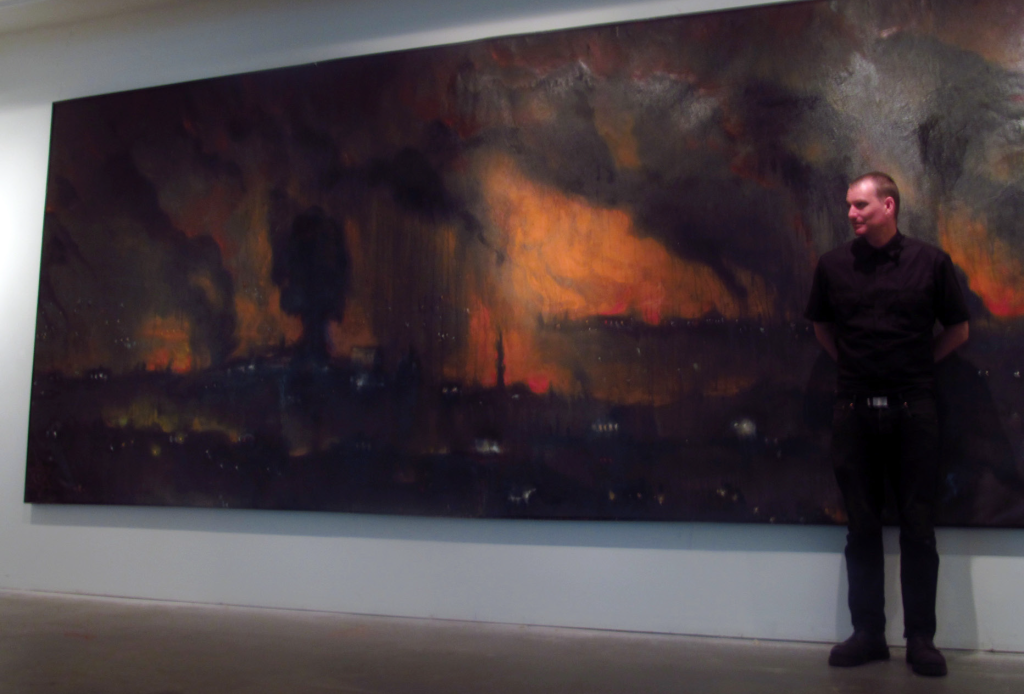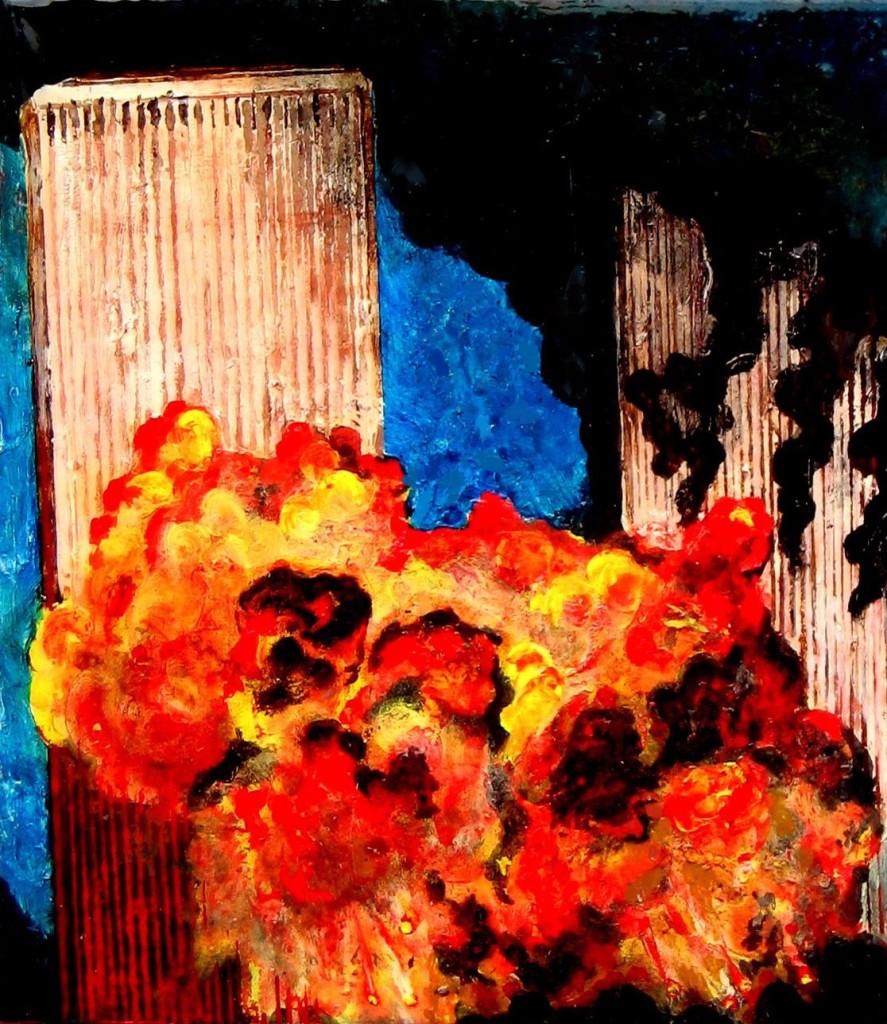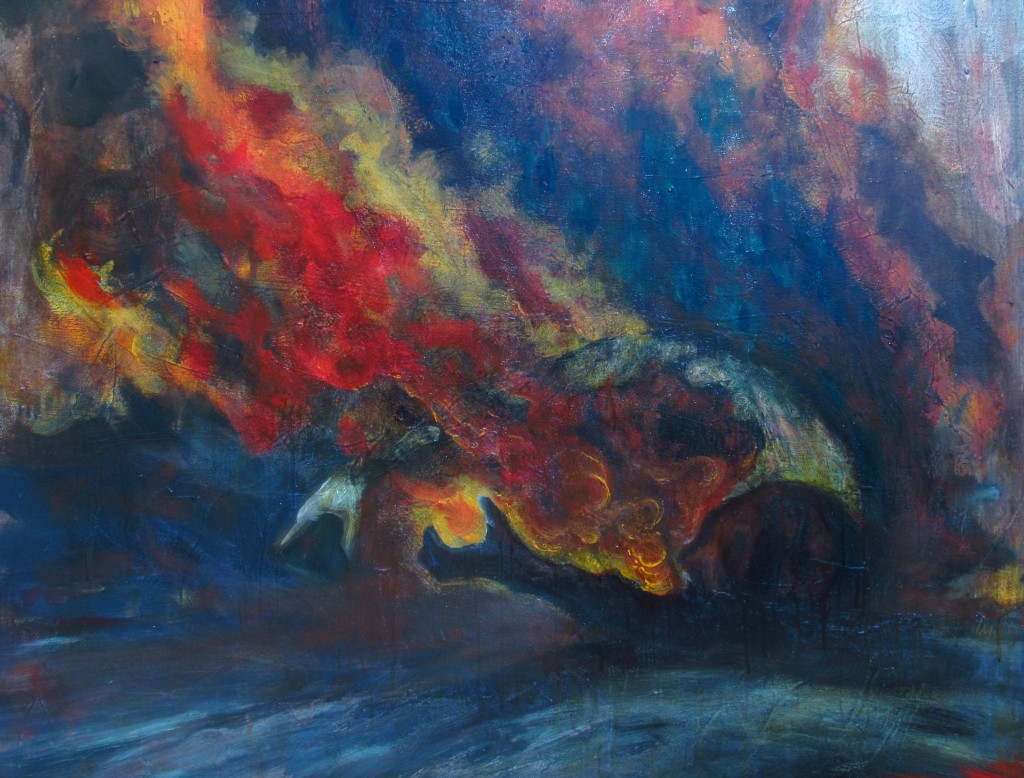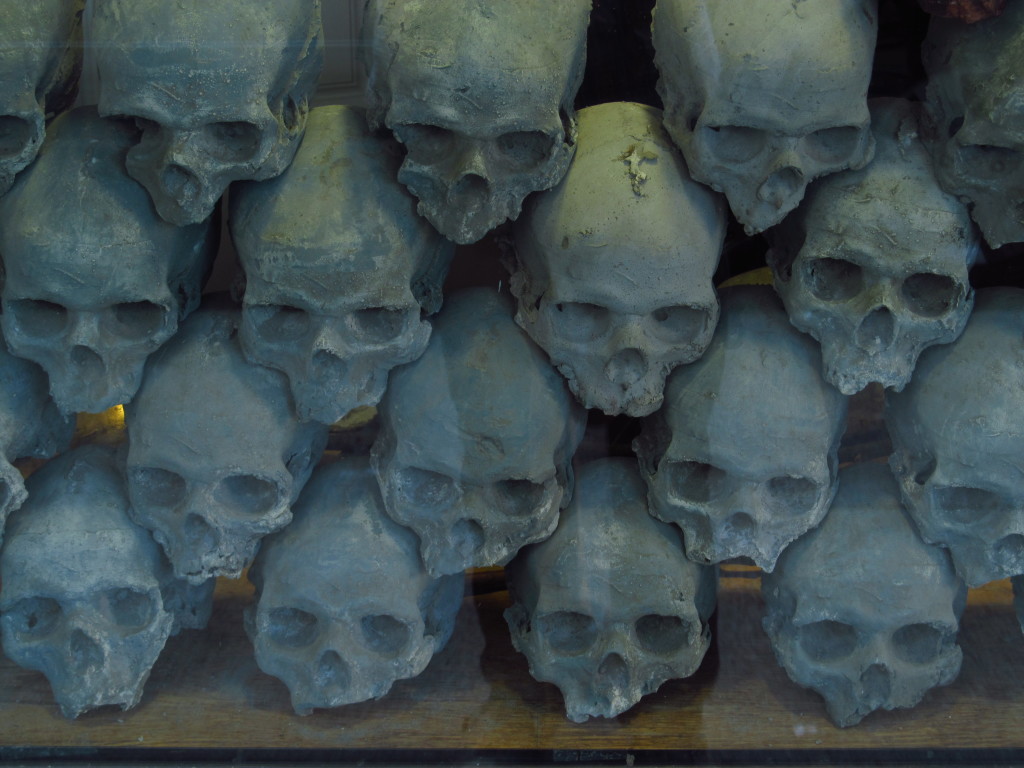Featured Artist Interview with Alex Lilly, conducted via email by Steve Parker and Dave Mehler
May 21, 2014 – June 12, 2014
STEVE: I’ve been scanning and re-scanning your pictures, and I’ve found a couple of videos on Youtube. There seems to be fire everywhere. Burning people. Bombings. On one of the videos you are beating away at red-hot metal like the Roman god Vulcan. What does fire mean to you? What is the fascination? Is it the thing itself or what it’s doing?
http://www.youtube.com/watch?v=7MDqB_c6EAY
ALEX: I had started blacksmithing because of the cold weather during winter. The rain, the sleet, the low hanging clouds, the furnace, the crucible, the anvil, the hammer, it’s the work that kept me warm. It was only after I had been doing metal work that I found out that I am a seventh generation blacksmith. The Reisingers out of York, Pennsylvania, were one of the first families to buy land from William Penn. My great-great Grandfather said that the clamor of steel was more beautiful than any opera. My family also made guns for the revolution. When September 11th happened, the newspaper images showed fire, ink-black smoke, on a September 11th blue sky. I imagined those images as paintings. Those images that flicker across e-media and newspaper and television media, flash in an instant, but when turned into a painting, their impact lasts, and becomes much more real.
After September 11th, America started bombing Iraq as some sort of made-up revenge. The American monarchy of the time needed to show a modern culture destroyed, Afghanistan was never enough. I realized in those images, flashing across all those screens, that the buildings being destroyed by American Tomahawk missiles showed plumes of ink-black smoke, fire, on the same blue sky. So, the work progressed, and I started painting American war scenes of humvees on fire, burning in the desert heat. The destruction gripped my heart. The work informed itself, from the oil-well fires in Iraq to the great catastrophe of the oil spill in the Gulf of Mexico, the oil burning off the surface of the ocean with great inky-black plumes of smoke, dark red fire, against the blue sky. And today it is oil trains exploding in the landscape, on a bi-weekly basis that no one notices, but the images are there.
In this banal world where anything can happen, peoples and cultures with no future and a rich past, told that they have no right to exist – fascinated by the prophecies of Armageddon, destroyed by militaries, bombarded by false facts – find themselves in a situation where no one would ever listen or care about anything they might say. Use the ultimate sacrifice, the ultimate form of protest to create an image that flickers for just a moment across the screen that no one will see. With no hope, the figures, ink-black on skin, dark fire, melting clothes, a silent scream, a last fiery breath, self-immolation against an indifferent sky. The indifference of nature, the indifference of violence, the indifference of people, the indifference of all those little screens. The ultimate pain. This is why I do the work.
STEVE: What would you change then, if you could?
ALEX: It’s not a question of change, it’s a question of resistance. It’s not a contest of who’s the better activist, better artist, better musician, it’s the day-in and day-out lifelong struggle towards some kind of greater good. No one is perfect, a person can only do what they can do in the situation that they are in. One can only work with the information that they have. The lies, the deceit, the double-speak. So, the target of resistance must change and be fluid everyday. Mistakes must be made and learned from. Life on earth would not exist without constant change, i.e. in addition, life would not exist without constant resistance. A person can give up and choose to not resist and fall, working against the greater good: greed, drugs, personal gain. But there will be someone or some thing that will be there to resist them. It’s a question of loyalty. You’re loyal to your family, your friends, your group, your collective, your tribe, your investors, your company, your country, your wars. Your loyalty to genocide is committed for your personal gain. This is the condition we all live in. Nothing can stand in the way of loyalty. So
everyone believes they have the God-given right to kill for what they are loyal to. One must consistently step back and try to help rather than harm – with a clear mind, pure heart, and just intentions.
STEVE: And just for nonsensical stuff, what is your favorite pop song? I bet you can’t answer that :0)
ALEX: When I think of the definition of a pop song, I think of a song that is cliche, non-political, and mostly non-specific. I think of a song that is about those things that are popular, but also timeless. So for this interview, I will write a pop-punk song about things that are popular and timeless, about friends and acquaintances who have given up. This, a cliche song about pelf and place.
All the kids kill on murder street,
All the kids die under battle-gray sky.
You’re life drowns down to a river of silt,
Street fighters give up and let themselves get killed.
You show a weakness to your vice and you die,
You’re life washed away by a battleship sky.
Blood red flag over a city of doom,
There’s no way out of the overdose room.
I consider this song to be popular because it is about people who have given up or disregarded political struggle and devolve into self-destructive and self-serving acts that inadvertently seem glamorous, but supports war lords and destruction around the world. Shooting up drugs, overdosing and dieing, they never get out of the overdose room, the coffee shop bathrooms.
STEVE: Alex, to get back to the fire, obviously several of your works deal with self-immolation. Could you say a bit about that and what the act means to you? It feels like an unbelievably powerful statement to me. I was pretty blown away when I first saw the classic photo of Thich Quang Dur burning himself to death on the street, and still am. It’s a heck of a violent thing to do as a peace protest. Could you tell us what you feel about the whole thing?
ALEX: Yes that image, the Buddhist Monk during the Vietnam era, is very, very powerful. I have chosen more recent images, on more contemporary acts of immolation. For instance, the 130 Tibetan self-immolations since 2009. The Iranian women self-immolating in the town squares. The man lighting himself on fire on the Washington Mall. And a situation that was closer to me, here in Portland, Oregon where a person lit themselves on fire in front of a Fur Store. I had got past that site that day because of the protest and saw the detritus all over the ground, in an ironic twist, the police that showed up at the scene of that immolation grabbed the wrong red canister, instead of grabbing a fire extinguisher, they grabbed a canister of mace, both in identical containers, and put the protestor’s flames out with pepper spray. The person died two hours later. Supposedly his last words were, “This is for the innocent animals that died, I hope someone loves me.” To me, what he did was an act of love. May he rest in peace.
I decided to paint these images because the images seem to be getting lost. The actions seem so grotesque and becoming common, that people are barely responding to them. To me these are the ultimate acts of political protest. In the case of the Fur Store incident, all of the protestors around that incident dis-regarded the person and their action as being crazy or illegitimate. I hear this over and over. And I also hear about acts of self-immolation happening over and over. Not just in other countries, but here in American in our towns and cities. These actions go on, and are disregarded. I find this appalling. To study these images, the images that flicker for a moment across the media screens. To actually capture the images and turn them into physical objects, first printed photograph on paper, then practically life size paintings, has also been a disturbing endeavor.
These acts of protest, I found, were not just acts of leftist ideology. The right-wing is self-immolating too. Even to me, it is hard to imagine dousing yourself with fuel, igniting yourself, skins burns, clothing melts into flesh, white raw burning flesh, char black soot, on the surface of boiling skin. In most cases, witnesses do what they can to put them out, but often it is too late. To me, this is the most powerful image. And to me, it had to be a continuation of my work. Like those people felt they had no other choice, I also felt I have no other choice but to comment on their actions and suffering. These are memorial pieces, to those martyred dead.
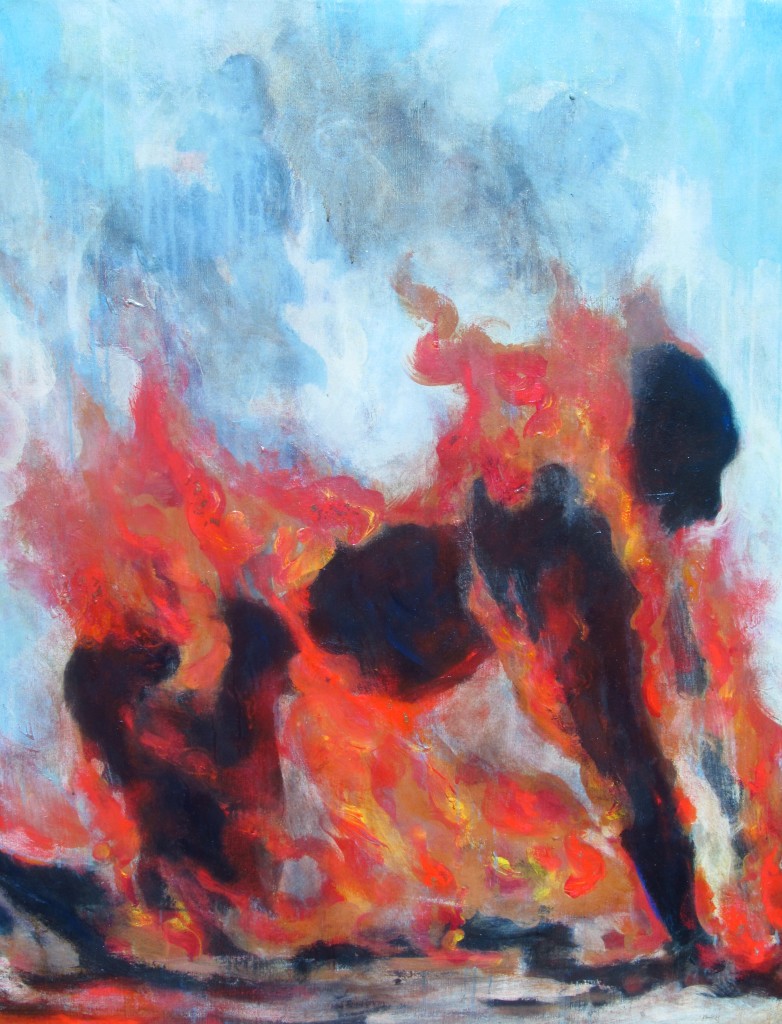 Unemployed Man on Fire–Tunisia, Alex Lilly
Unemployed Man on Fire–Tunisia, Alex Lilly
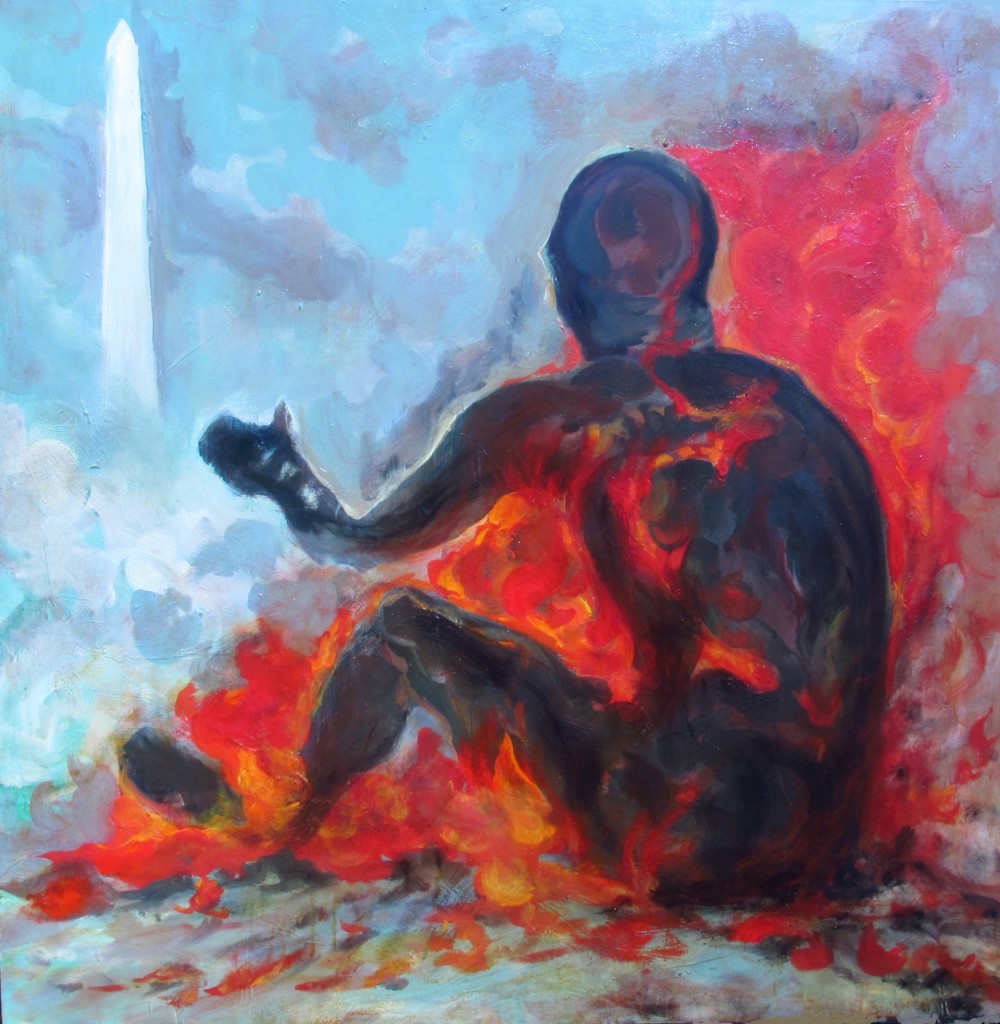 Washington Mall Immolation, Alex Lilly
Washington Mall Immolation, Alex Lilly
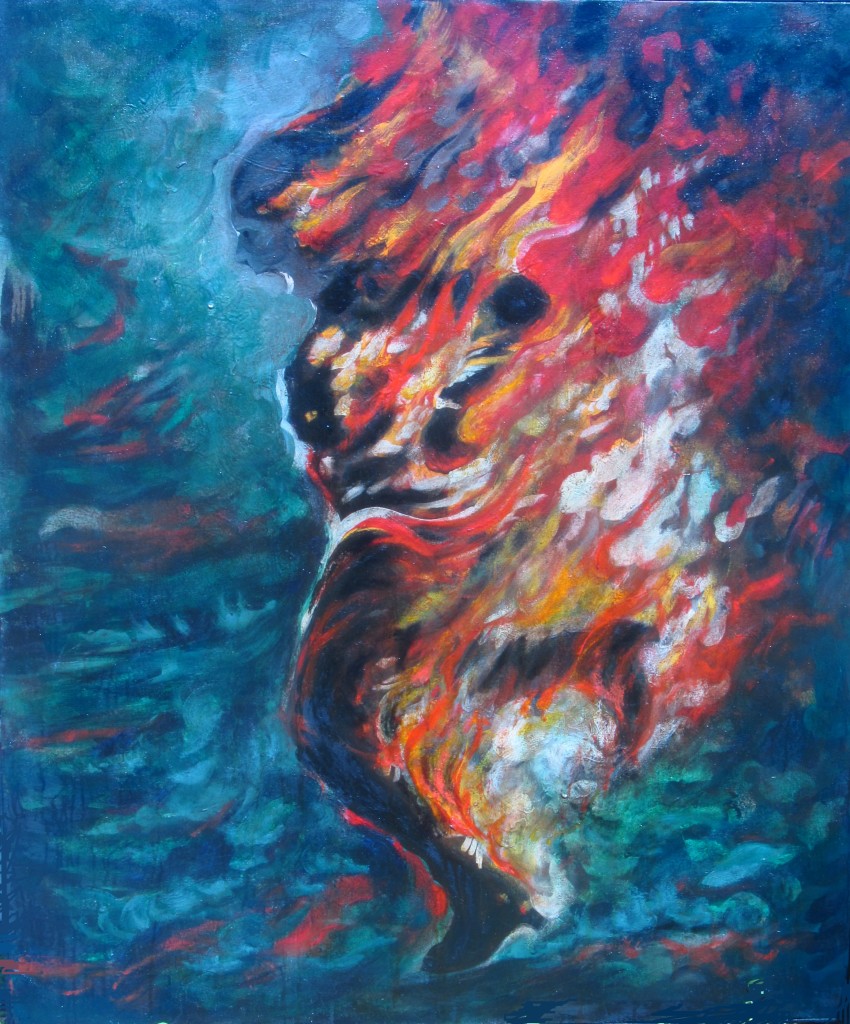 Protesting Racism–Luxembourg City, Alex Lilly
Protesting Racism–Luxembourg City, Alex Lilly
STEVE: This might be going off at a bit of a tangent, but let’s see how that pans out. In those pictures of Thich Quang Dur, he looks kind of peaceful, and certainly doesn’t look like you’d expect a man to look when he’s burning to death. Who knows, maybe all those years of Buddhist meditation had given him the ability to leave himself in some way and not register physical pain. I was unaware of these 130 Tibetan self-immolations since 2009 that you’ve mentioned. How do you figure all of that? Do you think highly trained Buddhists can do this stuff and not feel pain, or as much pain? And do you agree with the whole process as a form of protest or resistance? Would you do it yourself? And do you consider yourself religious in any way? Don’t forget you’re the Roman god, Vulcan! ;0)
ALEX: I have never considered the act of self-immolation to be a purely religious act. I only started doing paintings of it because someone in my town had done a self-immolation. For me, I consider the act of self-immolation to be an altruistic suicide for a collective cause. But upon looking at the subject, I found many instances throughout a deep and long history of religious self-immolations. I understand that the religious issues surrounding self-immolation are very, very, complicated, and I suppose that if your whole life is summed up by what you’re thinking at the exact moment of a political death, giving up the body for a political reason that, that moment must surely be a religious moment. People watching self-immolations must be filled with grief and admiration for someone willing to inflict such deep pain during a sacrifice towards a cause. In the mid seventeenth century, Russian Orthodox reforms caused whole villages of people to burn themselves to death, in a ritual called “fire baptism”. This seems to be political and religious. I had considered self-immolation to be political, because the first painting I did on the subject was of Mohamed Bouazizi, taking this action in Tunisia, which sparked the Arab Spring. I considered his action to be that of class-struggle. Many, many others have self-immolated with his cause in mind. I did not even know that thousands upon thousands have been self-immolating in India. The year 396 seems to be the first recorded Chinese self-immolation.
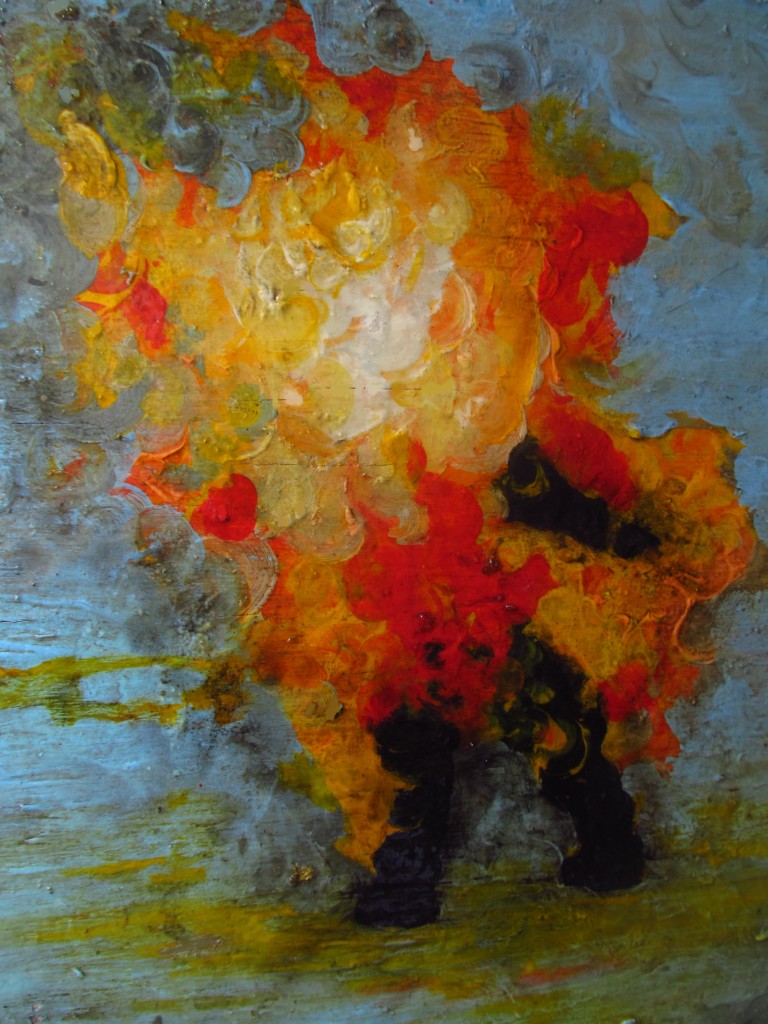 Young Man on Fire–Mohamed Bouazizi–Tunisia, Alex Lilly
Young Man on Fire–Mohamed Bouazizi–Tunisia, Alex Lilly
I had considered doing a performance art piece from a place of privilege, of lighting myself on fire – without being injured, but I personally cannot imagine the suffering it must entail, to actually complete that type of action. I am religious, in that I believe that if someone steals a piece of art or does not compensate an artist or laborer for their work, that stolen art or artifacts hold a deep curse against anyone that thinks they can just steal someone’s work. The curse affixed to those objects never goes away. The curse affixed to people that think they can steal artwork never goes away. Those curses get passed on through the generations.
As far as the Tibetan Monks go, their culture is being oppressed so severely by the Chinese government that most would see it as an understandable option. As political resistance, they feel pain and suffering as much as anyone else, if not more — because they are highly trained. Is it religious? Is it political? It is happening whether anyone likes it or not. All over the world. And it is a dark fire. I cannot even approach understanding what that action might be like for that individual. It seems so personal. Heartbreaking.
STEVE: And… kind of a primitive crunch question, but what do you really want us to get? If you paint a picture of a man burning himself to death, what do you want us viewers to receive from that?
ALEX: These are all just memorial pieces, a marking of the times? All of my paintings can be seen as purely political, conversely, as not political in nature at all. That they are memorial pieces, like relics in a church. The opinion will be in the eye of the beholder, who sees whether these paintings highlight the massive injustices of the world or not.
STEVE: A more traditional question, Alex: what sparked you off and got your fire going? I can remember artists and poets that inspired me deeply when I was a kid. Who first banged your anvil?
ALEX: Osama bin Laden. I never considered that I was going to be a painter before September 11th. Osama bin Laden was counting on me and the media to make images for his holy God-awful cause. My family, all “artists” live in that neighborhood, and they are all sick with asthma etc from inhaling all that shattered glass and pulverized corpses. If America wants to know where their loved ones are, they’re in my family’s lungs. I take all this death and destruction seriously. And I am fighting for my own life, merely to survive in this world.
When America’s response to Osama bin Laden was to let the antiquities of the museum in Baghdad be looted, I knew this would be the ultimate curse on America. Because she let all that artwork get stolen and destroyed, the curse would never be lifted and there would be hell to pay. In the month of May [2014] alone, over seven-hundred people were killed in sectarian violence under Maliki’s ineffective government. The number one target the so-called insurgents have the most fun blowing up are all those fat oil pipelines burning in the desert. And when I saw those Abrams Tanks rolling over old walls in Baghdad, I knew that those little walls, destroyed by those big tanks, were probably over 4,000 years old. And so it goes. Why anyone trusts America is a mystery to me.
DAVE: Pertaining to the depth of feeling you obviously have for the pain and injustices that exist in the world, and the process of working through that and responding to it by your art as memorial and active resistance. I’m wondering if you are optimistic first that your work will be seen, and second that it might take on a life of its own in the viewers heart and effect change. Do you ever worry that your art is too difficult to examine because of what it represents, or that it will remain hidden, in the same way the news and the surprising prevalence of these immolations seems to be from the public at large?
ALEX: Yes. It is the act of painting itself that can be cathartic, the twist of the brush, the layering of pigment, of stains, of finishes. During the act of painting, time falls away within the complete focus of doing the works, or a body of work. The moment that a piece of work is done, it no longer belongs to the artist. The ideas are kept sacred within the artist’s mind’s eye, but the work itself as an object ultimately belongs to the people, to the public, and to society at large. The responsibility rests on them, whether to suppress the work, or oppress the artist doing the work.
DAVE: I’m aware of poets who work in virtual obscurity. One of the missions of Triggerfish is to find and promote these people (all the more so when the work is accomplished, meaningful and worthy of attention). The reasons they write are less for an audience than for themselves for a variety of reasons: as a way of coping with a difficult or impossible situation, processing, or writing to think through or understand something as investigation, to represent and discern something like meaning, or as an expression of despair. They either have given up hope of obtaining an audience or community, or inexplicably don’t seem to need or want one. I tend to think art implies a maker and an audience and art without an audience is left unconsummated. Does an artist need an audience or can art be celibate? Does it require an audience to be fulfilled or real?
ALEX: I believe it can be both. I believe to a large degree that the public should be feared. The work of an artist is ultimately a solitary endeavor, the anger and violence of society has its power. It’s nice to think that there’s good in the world. And surely there is. But it’s the reactionary violence of an indifferent public that can put overwhelming focus on one individual, to destroy that individual, to keep them quiet, this is the indifferent nature of the physical world. The indifference of nature is in people too.
DAVE: It’s an interesting strategy you use to incorporate beauty into these grotesque images of destruction and death. Would you care to talk about how these mature decisions to deal with difficult social and political subject matter evolved for you? It would be so easy for someone with convictions and a determined ideology to forgo beauty and go for the throat through symbolism, pedantry, didacticism or irony and satire. Most do. Or, simply to paint horrific scenes horrifically. You suggest art is to go beyond activism to resistance, to be a form of protest. What it seems like to me though in these paintings is that you are wooing the viewer. Initially we are drawn in by the beauty of the painting and we look long enough to begin to consider the implications of what we’re seeing. This is similar to how parables work, seemingly innocent, mundane little stories but with a hidden sting or barbed hook in the subtext. How long did it take you to realize these effects—sounds like you’ve been painting for close to 15 years?
ALEX: Yes there is intention in the work, but the work informs itself. I had never considered myself to be a painter until the day after IXXI, as I stated before. In a sense you could say that the paintings aren’t political at all, or they could be seen as pro-war by people that just love fire and destruction. My work can be seen in both ways, and it is sometimes striking to me when it is seen in the opposite way that I thought that i was making it. For instance, I created a political poster, silhouettes of riot police that could be seen as soldiers, with the caption, “United We Stand On the Rest of the World”. The right-wing people of America love this poster. So my paintings, to me, are a commentary or marking of the times. The work also keeps me guessing. The thing that is dangerous to the individual artist is that people put their reactionary ideas on to me, as if they know everything about me, which enables them to attack me. They automatically assume because of their own prejudices, that I want people to light themselves on fire for my own amusement. It’s as if they see me as the opposite of what I am. That because I am doing paintings of destruction and death, that I somehow want all these wars to be happening. It makes things very dangerous for me. Just as it’s always been dangerous for the artist throughout time. I have had violence done to me for my work on several occasions.
DAVE: Do you see in fire possibilities of purification as well as destruction? Can pain be useful? Are the depictions of the destructiveness of fire and bombing in the paintings an attempt to do more than memorialize martyrs and victims but also perhaps to purify the culture?
ALEX: Are martyrs purifying their own cultures by making bold statements?
I suppose I am trying to get away from the prefabricated responses to all the wars, bombings, torture and suffering in the world. Perhaps I have learned that from this interview. Every nuance and flaw is revealed about any individual whistle-blower, artist, conscientious objector in the news media, whereas the normative state violence is celebrated with blind arrogance. Where nothing is analyzed about the wars and state oppressions, but the individuals that oppose it are picked apart by superficial pundits. Critical thinking is replaced by the death-cult promoted by power-grabbing bureaucrats.
DAVE: Is there something we’re not asking that you’d like to talk about or address pertaining to life, the world, work, and art? Thanks for the interview and allowing us to spread the word about your paintings!
The intention of these paintings is not to offer comfort. The paintings shed light on the disquieting act of committing oneself to political death. The political image has been used throughout the ages to sway or inform an audience. In ancient Iraq the story of Gilgamesh, known as the first written story, paints an imagine in the minds eye of a warrior leader, both cunning and kind, establishing immortality through a great deed. Gilgamesh is willing to make a personal sacrifice by confronting and killing a pride of lions. Kings, dictators and politicians replace Gilgamesh with their own image for their own personal gain. Art can be used for the greater good or for the bad. Trajan’s Column in Rome, known as the first epic story of war, carved in relief, carved in 656 feet if uncoiled. The column’s images shows soldiers buried under shields like today’s images of riot police fighting right-wing revolutionaries in the streets of Ukraine.
In the Etruscan Necropoli are painted the first known images of hell, frescoes of people rising from the dead, gradually becoming more and more morbid and grotesque. These paintings are known to reflect a change, from optimism to pessimism, with the Etruscans loss of political fortunes to the Greeks and the Romans. The image of a figure bleeding, suffering, on a cross, we regard it as a sacrifice image. It is a political murder, crucifixion known to be the punishment for treason against state power and its coffers. “And Jesus went into the temple of God, and cast out all them that sold and bought in the temple, and overthrew the tables of the moneychangers, and the seats of them that sold doves,” Matthew 21:12.
These images and icons tell stories. They burn meaning into a culture, just as a culture brings meaning to the artworks. The works are beautiful, terrifying, they inform and reflect what the people see in them. All the artwork belongs to the people. It is of the people. As people, we are hardwired to be arrested by these political images. We see that there is pain, that there is suffering in the work, we can imagine those things physically happening to us, and therefore hopefully empathize with an artworks deeper meaning. The intentions of my paintings, not unlike the exploration into the meaning of life, is to find the truth. There is an ultimate good in finding out the truth. To delve deep, ask the questions why, find out what is happening to people’s across the world and how they are reacting, socially, politically, spiritually. To delve deep and ask why is death so real. Why should the people, artists make monuments to death, war, romantic heroism, political struggle. I make beautiful images of horrible situations. I do my best to find images and create paintings that won’t be easy to disregard. Stories in brush work showing suffering that won’t be so easily forgotten. I will continue to do so until my own death.

